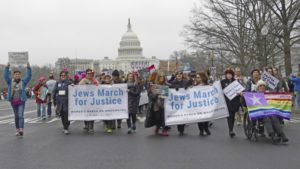
Supporters of NCJW and other Jewish organizations come together for the Women’s March on Washington, January 21, 2017. (Ron Sachs)
I haven’t marched for a cause since college, when I protested against the Vietnam War. Then I grew up, succumbing to myopic minutiae along the way. My focus narrowed, like my eyesight. Daily demands left no room for tranquil sunsets, let alone marches.
I knew about the Women’s March scheduled Jan. 21 in Washington, DC. Simultaneous solidarity events were taking shape everywhere — including Denver.
Obviously I planned to catch the local coverage. That’s my armchair style.
A good friend called me a few days before the Denver march and asked whether I’d accompany her. She expected me to decline. Much to my surprise, I agreed.
I woke up at six that morning and met my friend downtown by 8 a.m. Civic Center Park was only a leisurely 10-mnute stroll away. Typically prepared for the unknown, I wanted to arrive early.
But the moment we headed in the park’s direction, we were joined by 20-year-olds in colorful clothes; mothers holding their children’s hands; elderly couples.
I realized this march would be unlike any other.
As I neared Civic Center and melted into the humanity-swollen throng, my heart thumped inside my coat. I was about to enter the thick of it, yet I felt safe and secure.
I spoke to young women and men (there were many men at the march). I reminisced about the old days with my friend and with complete strangers the same age. I noticed a sign inscribed with a red-penned complaint: “I never thought I’d have to do this again!” The owner of the sign was my contemporary.
Bodies jockeyed for space — but we weren’t going anywhere. One hour passed. Two hours passed. Another half hour came and went. We stood still, freed by the occasional baby steps. Then we halted again.
“Let’s march!” we cried. “Let’s march!”
Cheers originating in some distant place swept over us like inaudible waves. When the noise subsided, I chatted with several women and the men standing proudly at their side.
Aware that many Jewish friends were at the march, our attempts to find them proved futile.
Despite our varying stances on the issues, we all supported equal rights and pay, and the abolishment of workplace discrimination and sexual harassment.
We demonstrated our dignity, now under duress.
After an eternity, thousands of women received unspoken marching orders. My stride picked up the slow beat. Thirty minutes later, I found myself on 14th St.
We owned downtown Denver that day.
I’m a small person. The sea of heads disoriented my directional compass. I could have been anywhere. Nothing made logical sense. Fine. I inhaled such solidarity — all around me and deep inside.
“This is amazing!” my friend exclaimed. “This is history,” I beamed.
As we wove through the mile-long route, strangers buttressed me like family. In addition to my contemporaries, I walked with girls who resembled my vibrant self in the early ‘70s. Women chanted a slogan, which men affirmed in unison.
It was paradise regained and redefined, in 2017.
My favorite call-and-answer, which overtook the crowds on numerous occasions, was “What does democracy look like? This is what democracy looks like!”
After being an unbeliever for so many years, I sprouted wings on the defiance of others. I was tired. My left leg hurt. But I was too elated to pay attention.
Downtown Denver applauded as we passed. People clapped on top of the Denver Athletic Club. Customers gave us a thumbs-up in packed restaurants. Police officers nodded to us.
Lately there’s been considerable discussion about the accuracy and legitimacy of crowd calculations. Admittedly, I could barely see above the shoulder’s in front of me.
I remember visuals of the Broncos’ 2016 Super Bowl victory parade. Headcounters claimed that between 800,000 and a million people lined the streets.
Based on my empirical experience on Jan. 21, at least 150,000 people participated in Denver’s Women’s March. Whether the exact number was higher or lower seems irrelevant. The overwhelming energy surrounding me transcended statistical comparisons.
The marchers turned left, then right, and continued for another 45 minutes. By that time, many participants were cheering us from the sidelines. They never really left us.
My friend and I continued until the very end.
No fights erupted that morning. There were no altercations — not even a one-on-one argument. I expected but never heard denigrating shouts from the peanut gallery.
Unlike some of the protests I engaged in during college, the Women’s March was peaceful because we were at peace. I’m not suggesting for a minute that intractable attitudes or policies will alter because of Jan. 21. We have a tough road ahead.
I will never forget a poster I read that day, which I wrongly attributed to Gandhi: “Be the change that you want to see in the world.” No one knows who actually said this.
Gandhi did say the following:
“If we could change ourselves, the tendencies in the world would also change.
“As a man changes his own nature, so does the attitude of the world change toward him . . .
“We need not wait to see what others do.”
I won’t.
Copyright © 2017 by the Intermountain Jewish News
















